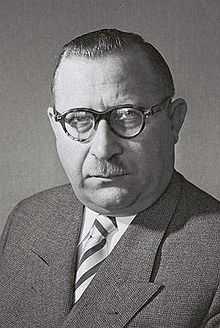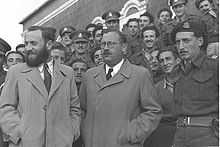Nathan Yellin-Mor
| Nathan Yellin-Mor | |
|---|---|
 | |
| Date of birth | 1913 |
| Place of birth | Grodno, Russian Empire |
| Year of aliyah | 1941 |
| Date of death | 19 February 1980 |
| Knessets | 1 |
| Faction represented in Knesset | |
| 1949–1951 | Fighters List |
Nathan Yellin-Mor[1] (Hebrew: נתן ילין-מור, Nathan Friedman-Yellin; 1913 – 19 February 1980) was a Revisionist Zionist activist, Lehi leader and Israeli politician. In later years, he became a pacifist who supported negotiations with the Palestine Liberation Organization and concessions in the Israeli-Arab conflict.
Biography
.jpg)
Friedman-Yellin (or Yalin ) was born in Grodno in the Russian Empire (now Belarus). He studied engineering at the Warsaw Polytechnic. He was active in Betar and Irgun in Poland. Between 1938 and 1939 he was the coeditor, along with Avraham Stern (Yair), of Di Tat ("The State"), the Irgun's newspaper in Poland.[2] He immigrated clandestinely with Stern to the British Mandate of Palestine and joined Lehi, a Jewish paramilitary group, Lohamei Herut Yisrael (Hebrew acronym LHI - in English, Fighters for the Freedom of Israel; called by the British the Stern gang).
In December 1941, Stern assigned Yellin-Mor to travel to Turkey to seek an agreement with Nazi Germany, who had failed to respond to Stern's 1940 offer of an alliance.[3][4] He later asserted that his motive was to rescue the Jews of the Balkans, though his biographer Heller finds this doubtful.[3] He was arrested near Aleppo before reaching enemy territory.[3]
Repatriated, he was put into detention by the British at Latrun. Yellin-Mor managed to dig a 74 metre tunnel, and together with 19 comrades, escaped in 1943. After Stern's death, he became a member of the Lehi guiding triumvirate, with Israel Eldad as chief of Lehi propaganda and Yitzhak Shamir as operations chief. Yellin-Mor looked after Lehi's political interests.

He was one of the planners of the assassination of Lord Moyne. He saw the struggle against the British in an international context, and advocated collaboration with other anti-colonialist forces, including Palestinian and other Arab forces. After the Deir Yassin massacre, he privately confronted Eldad.[5]
In 1948 he formed a political party, the Fighters List, and was elected to the First Knesset, from 1949 to 1951, where he was a member of the Internal Affairs committee.
After the assassination in September 1948 of United Nations mediator Count Folke Bernadotte, he was arrested along with Lehi member Matityahu Shmuelevitch and charged with leadership of a terrorist organization.[6] They were found guilty on January 25, 1949, the day on which Yellin-Mor was elected to the Knesset.[7] On February 10, 1949, Yellin-Mor was sentenced to 8 years imprisonment.[8][9] Though the court was confident that Lehi was responsible for Bernadotte's death, it did not find sufficient evidence that the murder had been sanctioned by the Lehi leadership.[9][10] The court offered to release the defendants if they agreed to certain conditions that included forswearing underground activity and submitting to police supervision, but they rejected the offer.[9] However the Provisional State Council soon authorised their pardon.[11]
In 1949, he denounced the Partition of Palestine as "bartering with the territory of the homeland" and opposed the Palestinian right of return.[12] Later, he moved increasingly to the left, in a return to the pro-Soviet position of some Lehi militants in the 1940s, by advocating a pro-Soviet foreign policy.[13] In 1956 he helped found the group Semitic Action, whose journalEtgar ("Challenge") he edited.
In his later years, he dedicated himself to working for reconciliation with the Palestinians, promoting negotiations with the Palestine Liberation Organisation.[5]
Publications
- Yellin-Mor, Nathan (1974). Fighters for the Freedom of Israel – Personalities, Ideas, and Adventures (in Hebrew). Jerusalem: Shiḳmonah.
- Yellin-Mor, Nathan (1990). Shnot BeTerem (in Hebrew). Tel Aviv: Kinneret. ISBN 978-965-286-237-2.
References
- ↑ Sometimes transliterated as Natan Yellin-Mor, Nathan Yalin-Mor, etc.
- ↑ "Tuvia Friling – A blatant oversight? The Right-Wing in Israeli Holocaust historiography". Israel Studies 14 (1): 123–169. 2009. doi:10.2979/isr.2009.14.1.123.
- ↑ 3.0 3.1 3.2 Heller, p90-91
- ↑ B. Wasserstein (1978–80). "The assassination of Lord Moyne". Transactions of the Jewish Historical Society of England 27: 72–83.
- ↑ 5.0 5.1 Shindler, Colin (2001). The Land Beyond Promise: Israel, Likud and the Zionist Dream. I.B.Tauris. pp. 182–183. ISBN 1-86064-774-X.
- ↑ Heller, p256.
- ↑ Heller, p261.
- ↑ Heller, p265.
- ↑ 9.0 9.1 9.2 "LHY leaders get 8,5 years", Palestine Post, Feb 11, 1949.
- ↑ Heller, p265-6.
- ↑ Heller, p267.
- ↑ Shavit, Jacob; Yaacov Shavit (1987). The New Hebrew Nation: A Study in Israeli Heresy and Fantasy. Routledge. p. 148.
- ↑ http://www.counterpunch.org/abourezk06062008.html James Abourezk,'Name That Terrorist', Counterpunch June 6, 2008
Bibliography
- Joseph Heller (1995). The Stern Gang — Ideology, Politics and Terror 1940–1949. London: Frank Cass. ISBN 0-7146-4106-5.
External links
- Nathan Yellin-Mor on the Knesset website
|